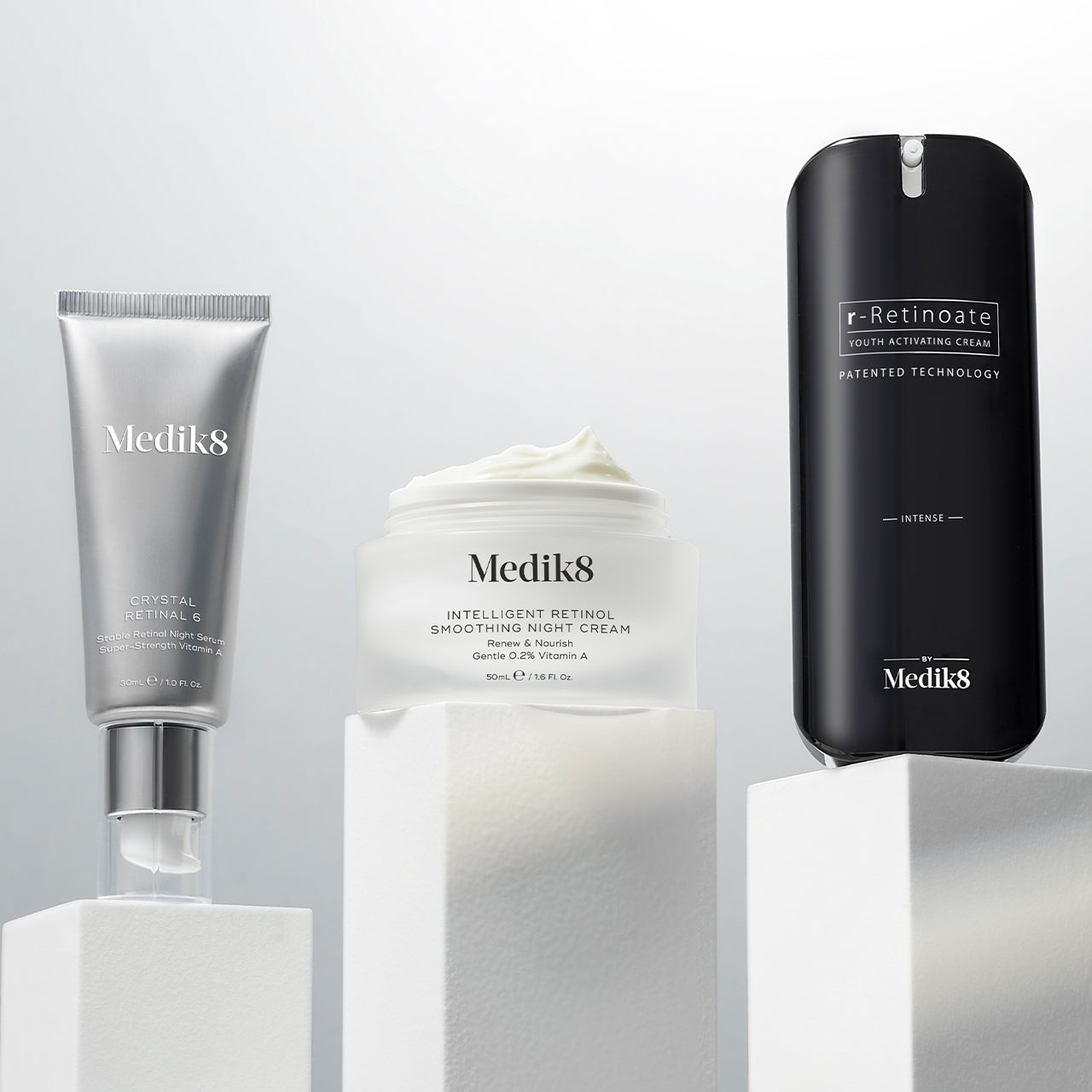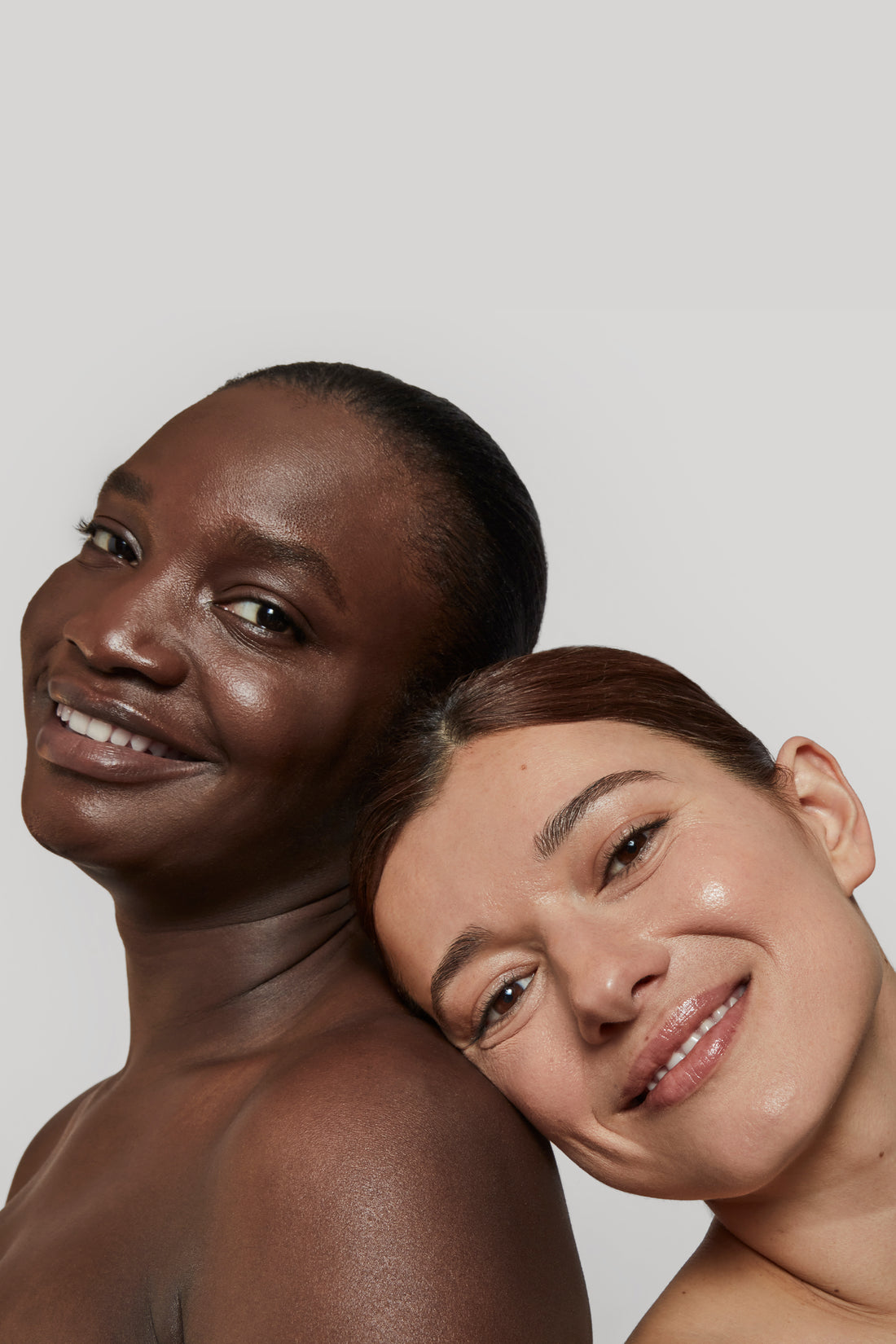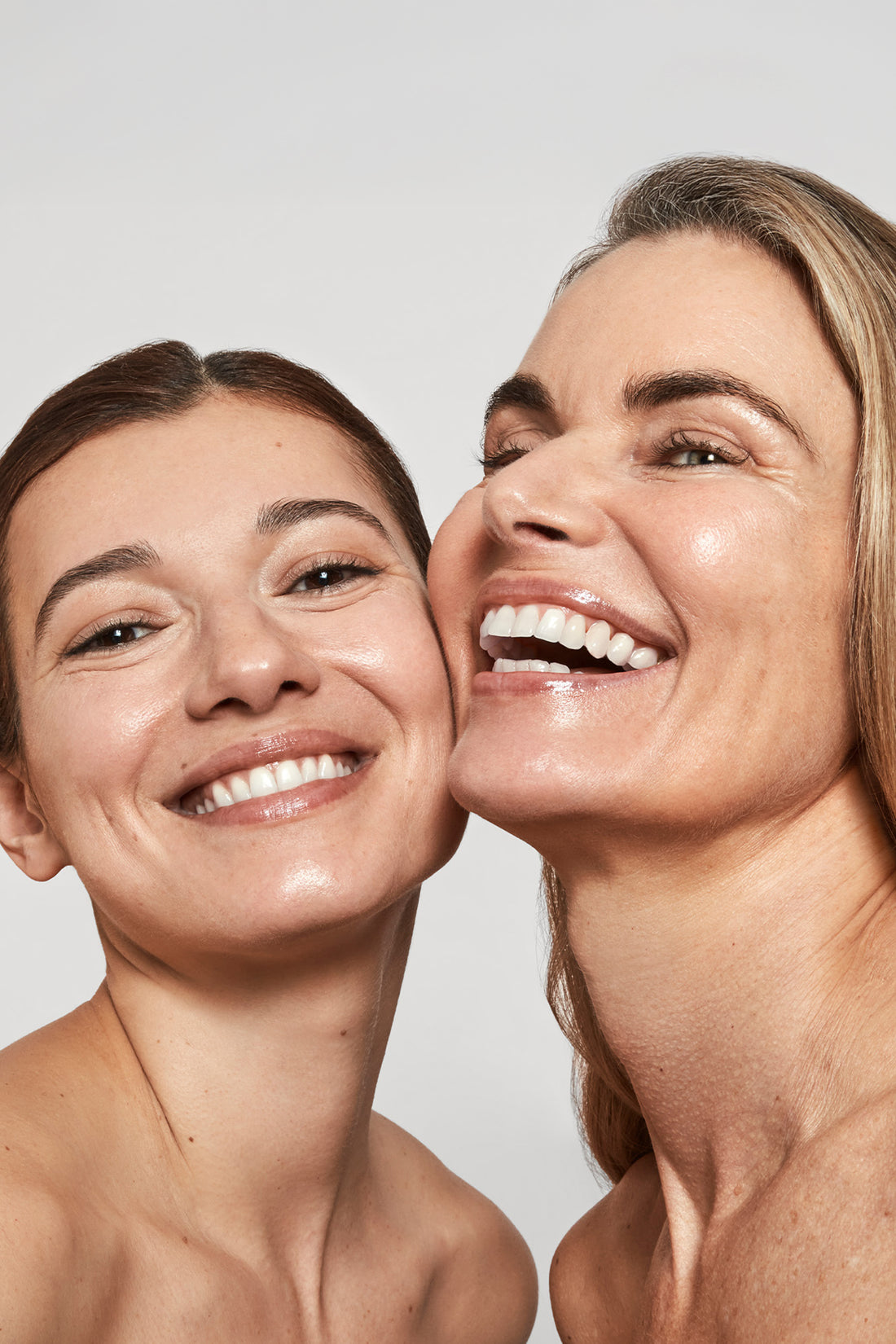A Guide on How to Increase Retinol Strength
Updated: 24th July 2025

As much as you think you know your skin, it can still be volatile when you’re experimenting with different products and increasing your strengths, especially when it comes to actives like retinol. Remember - good things come to those who wait, so be patient and proficient with your retinol application, and you’ll reap the benefits and avoid irritation at the same time. Win, win.
Considered the ‘gold standard’ of ingredients, retinol (a vitamin A derivative) is one of the very few skincare actives that has concrete evidence it works. Reducing the appearance of fine lines, improving skin firmness, smoothing uneven texture, clearing acne and visibly brightening the complexion, it’s no surprise retinoids are such a skincare hero.
However, not all vitamin A is equal and the stability, delivery method and retinol strengths will decide how well your skin adapts to it. It’s also why choosing your retinol, and then increasing your strength over time can be confusing - which is where we come in. We break down what retinoids are, how to choose the right retinol percentage, why, when and how you should increase your retinol strength, as well as recognising the signs your skin is giving you that you’re in a good place to take your (vitamin) A-game to the next level.
What are retinoids?
Retinoids are the umbrella term for all forms of vitamin A which includes retinol, retinyl retinoate, retinal, retinoic acid, retinaldehyde and hydroxypinacolone retinoate. While ultimately, they have the same goal within your skincare routine – to give you healthier, youthful-looking skin, the strengths vary. It’s why you can get both clinical strength retinoid and over-the-counter, milder versions depending on your skin concerns, tolerance and other products you’re using.
Slowing down collagen breakdown, stimulating cell turnover, boosting collagen and elastin, minimising the appearance of fine lines and wrinkles, reducing hyperpigmentation, balancing oil production and preventing acne outbreaks, retinol is a multitasking powerhouse.
And if you’re questioning whether you need it in your routine, the answer is yes. Although we naturally produce retinol, as we age, it decreases, which is why the experts say that you can start applying it topically from your 20s onwards, as the benefits of retinol far outweigh not using it.
Understanding the hierarchy of retinoids
Retinoids bring with them an air of confusion as they vary in strength and efficacy, but in short, to be effective on the skin, whichever form you choose needs to convert into retinoic acid – this is the ‘active’ component that essentially, does all the good stuff for your skin.
It’s the conversion process that makes all the difference. Requiring the retinoid to travel through a vitamin A pathway, each conversion process step weakens the resulting derivative's activity. A retinoid, like a retinyl ester, which requires three steps to convert into retinoic acid, is much gentler on the skin compared to tretinoin, which only requires one step for that transformation.
From low to high, here’s where each retinoid sits on the vitamin A ladder:
Choosing the right retinol percentage for your skin type
Like everything in skincare, choosing your retinol percentage will depend on your skin type and your skincare concerns. If you have sensitive skin, you need a version that won’t irritate and aggravate, whereas if you have oily skin, you’ll probably be able to tolerate a higher strength retinol than those with dry skin.
This is why we work with a retinol ladder system so you can up your vitamin A in increments, progressing through the strengths, allowing your skin to build up tolerance. Because it’s an ‘active’ ingredient, there are always risks it might cause irritation, so be mindful. If you were new to weight lifting, you wouldn’t go straight in with a heavy bar; you’d need to work up to it and create muscle memory. So have the same respect for your skin.
For retinol beginners, Intelligent Retinol 3TR and Crystal Retinal 1 are Medik8’s entry-level products, which will take you through the stages up to Crystal Retinal 20 and r-Retinoate Intense.

Low concentration vs high concentration retinol
One of the best things about retinol is that you don’t need extremely high concentrations to see results, and you can even see the difference when using low-strength retinol, around 0.01%. From here, you can move up to 0.03, 0.06, all the way to 0.2% retinol.
It’s important to remember, though that concentration isn’t the be-all and end-all. The delivery method – like our Time Release Technology - and the other ingredients retinol has been paired with will dictate a formula’s efficacy. That, and the type of vitamin A that’s being used of course. For example, 0.1% retinol isn’t the same strength as 0.1% retinaldehyde – the latter is stronger because it’s one step closer to converting to retinoic acid.
Why do you need to start with a lower-strength retinol
When it comes to retinol, you need a ‘low and slow’, ‘you do you’ approach. Don’t be influenced by anything other than your skin and how it’s behaving. Potent concentrations of retinol aren’t for everyone, and that’s OK you can still get results from lower strengths without the risk of irritating your skin.
The key is to start low and apply your chosen retinol 2-3 times a week to gauge how your skin feels and behaves. Retinol speeds up cell turnover, so it can cause roughness on your skin as the top layers shed, and this can also leave the skin barrier vulnerable to environmental skin aggressors. This will be especially apparent if you have dry or sensitive skin, so the key is to monitor your complexion.

When should you increase retinol strength?
If you’ve put in the time – remember at least six weeks - and you want to up your retinol strength level, do it in stages. Slow and steady wins the race, and if you’re seeing results with the retinoid strength you’re already using, you might want to stick with it for at least two or three months before increasing the levels.
Be honest with how your skin is responding, too. If you experience any flaking, burning, redness, or irritation, it’s best to take it back a few notches and apply it only once or twice a week, or maybe even not at all if the sensitivity continues.
Signs your skin is ready to increase retinoid percentage
Put in the time? Seeing results? Using retinol most days? Check in with the below signs to ensure you’ve passed the retinol initiation period, and you should be able to increase your retinol percentage with ease.
How to gradually increase retinoid strength
Don’t be disheartened if, as you increase your retinol strength, you experience more signs of your skin adjusting (dryness or irritation); this is sometimes referred to as retinization and is considered normal. If this happens, simply slow down, allow your skin to calm down, and then repeat the cycle.
How to move vitamin A molecule
If you’ve already started your vitamin A journey, your skin should be used to how it works and what it does, but if you decide to switch vitamin A molecules, for instance from retinol to retinal or from retinal to retinyl retinoate, it’s important to be mindful of any changes you experience. That’s because while you’re not starting from the beginning, the molecules do vary in strength.
As a general guide, if you’re using another brand of retinol and want to switch to Medik8, start with Intelligent Retinol 3TR, Crystal Retinal 3 or r-Retinoate Day & Night, unless your current product is over 0.7% retinol in which case you can enter your Medik8 journey with Intelligent Retinol 6TR.
If you’re using Intelligent Retinol and want to switch to retinal, pivot from Intelligent Retinol 3TR or 6TR to Crystal Retinal 3, or if you’re already on Intelligent Retinol 10TR, you can make the move to Crystal Retinal 6, but be sure to phase it in.
For r-Retinoate, the Day & Night can be incorporated by anyone straight away (including those using Crystal Retinal 1, 3, and 6) but our r-Retinoate Intense requires a gradual introduction and must only be applied at night. Only move to this if you’ve been using Crystal Retinal 10 for some time.
It’s also important to approach using retinoids cautiously when switching to a new product from a different brand because the stability and formulation of retinoids can vary, potentially affecting their potency and causing skin irritation.
Discover how to use retinal in your skincare routine.
Final thoughts
A clinically proven multitasking ingredient, retinoids have earned their top-tier status in the skincare world. Tackling everything from fine lines to blemishes, dull skin to a plumper appearance, they can be added into anyone’s routine from their mid-20s onwards – providing it’s done in a sensible way to safeguard your skin. And while there are increasing strengths and formulas, it doesn’t always mean you have to reach the top of the retinol ladder to achieve your desired results. Stick to the low and slow approach, monitor how your skin reacts, and don’t be influenced by anything other than your skin.
FAQ's
Not necessarily, if you are happy with the results you are getting with a lower-strength retinol and seeing visible changes with no adverse reactions, you don’t need to step up a level.
Yes. Starting at 1% retinol means more chance of your skin becoming irritated and sensitive. For beginners, we recommend starting on the lowest strength, which could be 0.1% retinol or 0.01% retinaldehyde and working your way up.
Everyone is different, and there are various vitamin A molecules you can incorporate into your routine. The strength of retinol that’s best will be determined by how your skin reacts, not the percentage on the label.
Medik8’s strongest forms of retinoids include both retinol and retinal. Crystal Retinal 6 offers a highly potent retinaldehyde formula, providing significant results while being gentler than traditional retinol. For those seeking a more gradual approach, Medik8’s Intelligent Retinol range provides effective, sustained-release retinol that reduces irritation. These options deliver powerful anti-ageing benefits without the harsh effects often associated with stronger retinoids like isotretinoin.
If you’re not seeing results and you have been using your product for six weeks – a full skin cycle – then you may want to consider upping your retinol strength.
A slow and steady increase is best, and that could take months, not weeks, to achieve. As you increase your retinol strength, ensure you leave at least six weeks between products, if not more. Monitor how your skin reacts, and phasing in a new retinol is always a good idea. That could be using it twice a week or every other night if your skin is already accustomed to the active ingredient.
If you’ve been using retinol consistently and have noticed visible improvements, but feel your skin could benefit from more frequent use, it may be time to gradually increase how often you apply it. Start by using it 2-3 times a week and work your way up, allowing your skin time to adjust. If irritation occurs, dial back the frequency. Consistency is key for retinol’s effectiveness in improving skin texture, reducing fine lines, and fighting signs of ageing.
Ideally, you would start with 0.1%. Even if you have no sensitivities, lower is better, so in this case 0.3%.
Yes, because it is one step closer to converting to retinoic acid on the conversion pathway. It is the strongest version of vitamin A you can get over the counter.
[1] G. Siegenthaler et al., Retinol and retinal metabolism, Biochemical Journal, 1990, 268, pp 371-378
[2] H. Kim et al, Synthesis and in vitro biological activity of retinyl retinoate, a novel hybrid retinoid derivative, Bioorg. Med. Chem., 2008, 16, pp 6387–6393






